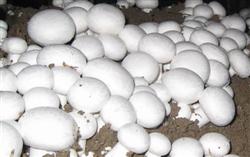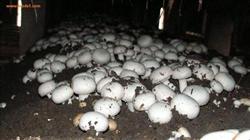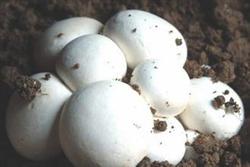Cultivation technique of Pleurotus ostreatus with Straw

The strain selected by strain selection must go through the mushroom experiment before it can be used on a large scale. The appearance must have thick white, stout, uniform hyphae, no growth interruption, no miscellaneous bacteria infection, no insect pests. Before disinfecting and feeding the mushroom room, clean up the mushroom room and indoor items, and then disinfect it. Disinfection is generally fumigated, with 10 milliliters of formaldehyde per cubic meter, 5 grams of potassium permanganate, sealed for 24 hours, and then open the window to exhaust. When the mushroom room is odorless, the culture material can be moved into the mushroom room. If the seal is not good, you can spray the surrounding walls and mushroom beds with 50 times the stone sulfur mixture. The stacking of culture materials should be paid attention to: the quality and reasonable formula of raw materials, and the use of fermentation technology to make the culture materials be fully decomposed by actinomycetes. The raw materials used to cultivate mushrooms must be fresh, dry and mildew-free. The formula of the culture medium should be based on the ratio of carbon to nitrogen (usually 33:1 before fermentation) and the ratio of nitrogen, phosphorus and potassium (usually 4V / L / 1.2 / v / v) for mushroom growth. The formula of culture material should be flexibly mastered according to the situation of raw materials in this area and the requirement of reasonable C / N ratio. The surface of the pile was treated with disinfectants and insecticides two days before the sowing and culture materials were dismantled. After dismantling, when the temperature of the material drops to about 28 ℃, spread the culture material in the trough with a thickness of 15ml and 20cm, and spread or hole sow or strip sow evenly on the material surface. Then spread 3.3 cm thick culture material, and finally heat preservation and moisturizing bacteria. It is necessary to maintain good ventilation conditions and suitable temperature and humidity in the mushroom room during the germicidal stage after sowing. Keep the temperature at 22 / 24; the air relative humidity is 65% / 75%; it can be ventilated and ventilated by opening the window or opening the film properly, and pay attention to replenishing water and moisturizing. Cover the soil less than 30 cm, sift it into coarse soil and fine soil, expose to the sun for 2 days before use, add 1% 2% lime or spray formaldehyde to kill diseases and insect pests. Adjust the soil to semi-wet, first cover the coarse soil 3mur4 cm, flatten it with a wooden board, then make the soil water content up to 60% 65%, cover the soil for 10 days, when the mycelium is unearthed 1 / 2, then cover 1 cm of fine soil, scrape the top with hands to make the thickness uniform. After covering the soil, punch holes in the material surface and ventilate properly. Early bed moisturizing (relative humidity 75%), using light at both ends, heavy in the middle of the water spray method, each spray water, should open the doors and windows ventilation. Lower the temperature to keep it at 12 ℃-18 ℃. Management after mushroom harvesting each kind of mushroom can be harvested with 4 Mel and 5 tide mushrooms. Each Pleurotus ostreatus can last several days. The interval between the two mushrooms is the adjustment period, during which the dead mushrooms and residues on the material surface are cleaned, water spraying and topdressing are applied. Mainly include: mushroom soup, grass spray wood ash water, salt water, soybean milk juice, and Fresh Carrot Juice and so on. The management during the overwintering period is mainly heat preservation and ventilation. In general, clear water is sprayed every 8 days to keep the soil surface from whitening (about 15% water content). The indoor temperature is kept at 3 ℃-4 ℃, normal weather, window is open for 2 min for 3 hours every day. In the middle of March, when the temperature is more than 10 ℃, the water can be adjusted and nutrients can be replenished. When the temperature reaches 15 ℃-25 ℃, it is the best time for spring mushrooms to produce mushrooms. The diameter of the mushroom cover is 2mi 4cm, the mushroom ring is not broken and the mushroom umbrella is not opened. Diseases and insect pests and their control of mushroom diseases and insect pests should follow the principle of "prevention first, comprehensive control", and comprehensive control should be carried out by using agricultural, chemical, physical, biological and other technologies. Biological control can use agricultural antibiotics to control bacterial viruses and improve the disease resistance, yield and quality of mushrooms. Parasitic nematodes are used to control flea flies, gall mosquitoes and eye mosquitoes. The main control methods are to do a good job in mushroom room, culture material disinfection, post-fermentation, pay attention to mushroom room hygiene, due to different diseases and insects, appropriate use of drugs. Chemical control: the use of pesticides is not recommended in mushroom cultivation, especially in the mushroom emergence period. Pesticides with high efficiency, low toxicity, low residue and harmless to humans, animals and mushrooms must be selected when using pesticides, and appropriate concentrations should be mastered to control them.
- Prev

Effective measures to control the size of Pleurotus ostreatus
In recent years, the market demand for the quality of Pleurotus ostreatus continues to improve, large mushrooms are not popular, some mushroom farmers can not keep up with the market demand to produce certain specifications of commercial mushrooms, resulting in increased production but not income. The specification can be controlled by the following measures. The strain "2796", which is now widely used in replacement strains, is a large-grained strain.
- Next

Management techniques of interplanting Pleurotus ostreatus with cucumber
When the temperature in the greenhouse is strictly controlled, the temperature in the greenhouse should be controlled at 20 ℃ ~ 30 ℃ in the daytime and more than 10 ℃ at night. When the daylighting is not enough in cloudy days, when the shed temperature is low, it is necessary to appropriately use electric lamps to increase the lighting and temperature at night, and install a 100-watt bulb every 6 meters. As the cultivation of Pleurotus ostreatus on the ground, mainly affected by the ground temperature, therefore, the shed.
Related
- Fuxing push coffee new agricultural production and marketing class: lack of small-scale processing plants
- Jujube rice field leisure farm deep ploughing Yilan for five years to create a space for organic food and play
- Nongyu Farm-A trial of organic papaya for brave women with advanced technology
- Four points for attention in the prevention and control of diseases and insect pests of edible fungi
- How to add nutrient solution to Edible Fungi
- Is there any good way to control edible fungus mites?
- Open Inoculation Technology of Edible Fungi
- Is there any clever way to use fertilizer for edible fungus in winter?
- What agents are used to kill the pathogens of edible fungi in the mushroom shed?
- Rapid drying of Edible Fungi

